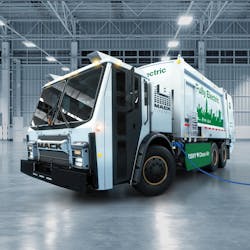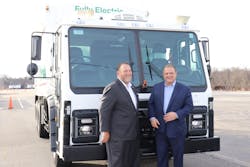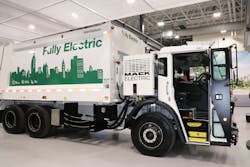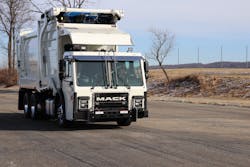Mack LR Electric ride and drive
As I stood on the Mack Trucks test track at their customer center in Allentown, Pennsylvania, noises filled the cold, still air. The private airfield adjacent to the lot had planes coming and going, the crowd of press and Mack employees were vying for the next-in-line position to drive the new truck, and the familiar hum of an engine from the LR diesel model also on site created an encompassing clamor. But what stood out the most amidst the scene was the silence of the Mack LR Electric truck. I could hear the propeller of a taxiing Cessna over 200 yards away from me, yet the idling full battery electric LR Electric refuse truck, not 10 feet from my ears, didn’t seem to make a sound.
The crowd was on-hand to see the demonstration of the Mack LR Electric - the full battery electric, zero emissions refuse truck being showcased and delivered in partnership with the New York City Department of Sanitation (DSNY).
DSNY and Mack Trucks have a strong relationship that has spanned a quarter century. Today, the DSNY fleet includes nearly 3,000 Mack trucks. In part due to this long history, DSNY will be the first to test the Mack LR Electric; add to that the ideal proving grounds that are the streets of New York City, a department with the resources to test such a vehicle, and a city keen on changing the environmental impact of their public services, the Mack LR Electric will be in the best situation to determine the viability of converting the DSNY into a battery electric vehicle (BEV) fleet in the future. Rocky DiRico, deputy commissioner of DSNY, emphasized the OneNYC “Clean Fleet Plan” – detailing the department’s goal of reaching an 80 percent reduction in greenhouse gas emissions by 2035.
The LR Electric, having zero vehicle emissions, will be pushed to the limit in this test run through the DSNY in order to determine whether it will be able to be scaled to a fleet comprised of BEVs. The metrics that the LR Electric will be measured against include vehicle uptime, range, driver feedback, acceleration, payload, regenerative braking, gradeability, charging time, and more. DiRico furthered the notion of NYC’s ideal proving grounds, explaining the variations of routes, mileage, number of stops, seasonal weather, and more, which result in a culmination of scenarios that can be extrapolated from this test and conceivably applied to routes that exist around the country.
Not only will the vehicle’s performance be measured and tested, but Mack is intently focused on developing a maintenance program for the full electric vehicle.
“It is going to be a mutual effort to maintain it,” said Jonathan Randall, senior vice president, North American sales and marketing, Mack Trucks, speaking on the maintenance plan for the LR Electric’s implementation into DSNY’s fleet. “We know it doesn’t have as many moving parts [as the diesel-based LR refuse model], we know that you’re not going to have the same brake wear and those kinds of things. From that standpoint alone, there is going to be less wear and tear and maintenance costs. But the good news is, as we test this, we find out as we go. It will be a process between us and their technicians as well.”
“Training is part of the plan for the whole project,” said Scott Barraclough, technology product manager, Mack Trucks. “The project is to deliver the truck, of course, but then we also have to deliver the ecosystem around that. The technicians will need training, as will the towing companies, first responders, et cetera.”
Randall and Barraclough said that technician training development is well underway. In this initial test, the Mack Trucks engineering team will be working together with DSNY, monitoring and maintaining the LR Electric as DSNY will provide routine maintenance and the Mack Trucks engineering team will focus on emobility-related maintenance. Barraclough also mentioned that the Mack Trucks Academy is currently developing a training program for the Mack BEV and will be taking information from this DSNY program to help shape how that training will be administered in the future and the important aspects it will focus on, particularly high voltage and safety.
The Mack LR Electric
The power source of the LR Electric is a set of two AC motors with 370kW (496 hp) of total peak power at the rear wheels, with 260kw (349 hp) of continuous power. The LR Electric houses four NMC lithium-ion (Lithium Nickel Manganese Cobalt Oxide) batteries which feature fast charge capability. The vehicle’s auxiliary power includes 12V, 24V, and 600V circuits, powering steering assist, pneumatic, and climate systems (with the cab systems at 12V, the air, power steering, and compressors at 24V, and the body drive at 600V). The charging system can handle up to 150kW of charge power with a maximum current of 200A, 500-750V, and is SAE J1772 compliant. The LR Electric has a two-speed Mack Powershift transmission that features 4,051 lb-ft of peak output torque.
Another major component of the vehicle is its two-stage regenerative braking system. The regenerative braking system can be set to 'Auto,' 'High,' or 'Low.' The 'Auto' setting is designed to have minimal impact on vehicle braking and is intended to be used when driving to and from the refuse route. The 'High' setting is designed to have a higher level of regenerative braking impact and is intended to be used when the vehicle is loaded with refuse. The 'Low' setting is designed to have a lighter level of regenerative braking impact and is intended to be used when the vehicle has little to no refuse onboard. The parameters of the 'High' and 'Low' settings are adjustable to fleet and driver preferences.
As the gold and silver bulldog ornaments have been signatures on Mack trucks in the past, the LR Electric adorns a copper-colored bulldog, as will all of Mack’s fully electric vehicles.
The drive
I first drove the Mack Trucks diesel LR refuse model on the test track, maneuvering through a set of cones and completing the quarter-mile lap, for comparison purposes. Straightforward, no surprises, things felt natural.
When I finally had the opportunity to drive the LR Electric, I was excited and ready to see the differences between the two vehicles. First things first, seat belt. Check. Foot brake. Check. Park brake. Check. Okay – let’s see how this thing takes off.
The acceleration was immediate, smooth, and impressive. As mentioned, the LR Electric has a two-stage regenerative braking system. I left the lot with the regenerative braking system set to ‘Auto,’ controlled through a simple switch on the center panel, and proceeded to take the short lap around the track. As I applied the foot brake at the first stop sign, I felt the regenerative brakes kick in, yet it was not determining the vehicle’s stopping distance to the extent that my use of the foot brake was. When I hit my first bank, I coasted through the turn and did not feel the regenerative brakes affect the vehicle at all.
I approached the maneuvers test lot, glad to see some cones had already been knocked over and relieved that I wouldn’t be the first or only one to hit something with this one-of-a-kind vehicle. I switched the regenerative braking system to ‘High’ and went ahead. I got up to a reasonable 20 mph and took my foot off the throttle; the regenerative brakes set in instantly and noticeably, so as I rocked forward in my seat and the truck came to a creeping roll. Now, the vehicle was not loaded and the ‘High’ setting is to be used when there is ample refuse onboard, but I wanted to at least feel just how strong this system was.
I then took the vehicle through a winding "S" and approached a K-turn. Naturally, I took my foot off the throttle and attempted to coast into my turn – I was abruptly reminded that the regenerative brakes were still set to ‘High’ and the vehicle nearly stopped in its tracks. This will be something drivers will have to get used to – and stay cognizant of – but I am sure will be resolved with time behind the wheel.
I completed the K-turn and set the regenerative braking system to ‘Low.’ I went through a ‘typical’ refuse route straight-away, with stop and starts every 50 feet or so. The throttle pedal becomes more of a drive pedal in the 'Low' setting. The relief of the throttle does not just slow acceleration but also initiates adequate braking to bring the vehicle to a near full stop; I completed the full stop with a press of the foot brake. Comfortable, easy, and convenient.
The parameters of the ‘High’ and ‘Low’ settings on the LR Electric can be specified to meet the needs of the fleet or driver preferences. It will be interesting to see how that fluctuates from route to route or fleet to fleet in the future, as the benefits of regenerative braking are capitalized upon.
Now what?
The Mack LR Electric is on its way to the Big Apple, the outcome could have a tremendous impact on the industry as a whole, and I am sure plenty of eyes will be on this project as it moves forward and benchmarking reports are completed. The industry has heard about vehicle electrification and the potential impact BEVs can have on GHG emissions, and we’ve heard the pros and the cons of adding BEVs to a fleet. This is a major step forward, as the DSNY – a large fleet and a public department – is taking the initiative in reducing their emissions and putting a fully electric, Class 8, heavy duty vehicle into real-world application in the United States.
About the Author
Tyler Fussner
Associate Editor | Fleet Maintenance
Tyler Fussner is Managing Editor - Community Manager at Supply Chain Connect, part of the Design & Engineering Group at Endeavor Business Media.
Previously, Fussner served as the Associate Editor for Fleet Maintenance magazine. As part of Endeavor's Commercial Vehicle Group, his work has been published in FleetOwner magazine, as well as Bulk Transporter, Refrigerated Transporter, and Trailer-Body Builders.
Fussner's May 2022 print feature 'The dawn of hydrogen trucks' was named the best single technology article in B2B by the judges of the 2022 Folio: Eddie and Ozzie Awards. Fussner was also awarded Silver in the Technical Article category for the Trade Association Business Publications International (TABPI) 2021 Tabbie Awards.
Fussner previously served as Assistant Editor for Endeavor's Transportation Group on the PTEN, Professional Distributor, and VehicleServicePros.com brands.
Fussner studied professional writing and publishing at the University of Wisconsin-Whitewater. He has experience in shop operations, is a Michelin Certified Tire Technician, and a Michelin Certified Tire Salesperson.





